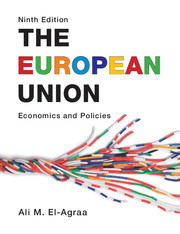Book contents
- Frontmatter
- Contents
- Figures
- Tables
- Boxes
- Contributors
- Preface
- A reader’s guide
- Abbreviations
- 1 General introduction
- Part I EU history, institutions and legal dimension
- Part II EU market integration
- Part III EU monetary integration
- Part IV The single European market
- Part V EU budget and structural policies
- Part VI EU external relations
- Part VII The future of the EU
- Bibliography
- Author Index
- Index
Preface
- Frontmatter
- Contents
- Figures
- Tables
- Boxes
- Contributors
- Preface
- A reader’s guide
- Abbreviations
- 1 General introduction
- Part I EU history, institutions and legal dimension
- Part II EU market integration
- Part III EU monetary integration
- Part IV The single European market
- Part V EU budget and structural policies
- Part VI EU external relations
- Part VII The future of the EU
- Bibliography
- Author Index
- Index
Summary
Preface
The European Union (EU) is the most significant and influential of international economic integration (IEI) schemes. There are three reasons, the sum of which explains this significance:
Of the six EU founding states, (West) Germany, France and Italy were top ten world economies. Since then, two such economies have joined: the UK and Spain. Hence today the EU includes half of the world’s top ten economies. The EU has also proved a magnet for new members: in addition to the founding member nations, known as the Original Six, there are now an additional twenty-one. The EU of twenty-seven continues to receive applications for membership; hence it is set to include practically the whole of Europe, and may go beyond the geographic area if Turkey succeeds in joining in 2015. No other scheme matches this economic size and diversity.
From a voluntary viewpoint, the EU is the oldest IEI scheme in operation; voluntary in the sense that countries are not coerced into joining, due to their being dominated by a foreign country or captured by war. This longevity is part of the EU’s attraction.
Most vitally, the EU has the deepest scheme of IEI. It is almost a complete economic union: (a) it is practically a complete ‘common market’, where people, goods, services and capital move freely – the four freedoms; (b) sixteen of its twenty-seven member states have the same currency (euro), with the European Central Bank in charge of Eurozone monetary policy; (c) it has a system for monitoring and influencing fiscal policy – the Stability and Growth Pact; and (d) it has its own budget, financing a range of policies. Also, since the entry into force of the Treaty on European Union (TEU), popularly known as the Lisbon Treaty, on 1 December 2009, it has: (e) a single president of the European Council; and (f) a foreign policy chief who controls a vast diplomatic corps, now being established.
That is why the EU is fascinating to study, and this book attempts to guide those who care about an ‘ever closer union’ for the people of Europe. But it is not confined to ‘Europeans’, since the EU offers lessons for all countries that try to learn from it or even emulate it. This is not to suggest that the EU is heaven – far from it; it has always had its serious problems, some bringing it close to complete collapse: witness the financial and economic crises it has been experiencing since 2007, which prompted many to speculate on the imminent demise of the euro. But this is inevitable, given the diversity of EU peoples and economies.
- Type
- Chapter
- Information
- The European UnionEconomics and Policies, pp. xvii - xixPublisher: Cambridge University PressPrint publication year: 2011



